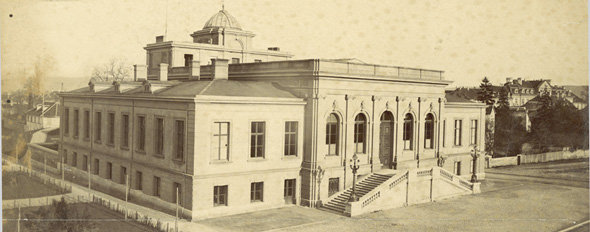The Bernoullianum: history of an extraordinary building
The idea for the Bernoullianum was born from a desire to build an observatory in Basel. A private foundation created a financial basis for the plan in 1860, which was then expanded in the following years. On 2 June 1874, the new building, now also providing space for physics, chemistry, and astronomy, was inaugurated with a celebration. In 1926, the building received new occupants with mineralogy, geology, and geography, as chemistry and physics had since moved into their own structures. The observatory finally moved in 1928 into a new building in the St. Margarethen complex in Binningen.
The project could only be realized through funds generously donated by Basel citizens to celebrate the four hundredth anniversary of the university. In 1874, the Institutes of Physics, Chemistry, and Astronomy moved into the building. Moreover, publicly popular lectures in the large auditorium made the Bernoullianum into a center of civic education.
In its day, the building was one of the first constructions to be outfitted with all the latest equipment for physics, chemistry, and astronomy.
At the beginning of the twentieth century, however, these institutes had to move into new buildings for want of more space. In 1926, mineralogy, geology, and geography then moved into the spaces this opened up. Since 1928, the Basel Observatory has been located on Margarethen Hill near Binningen in Basel-Countryside, not only because it, too, needed more space, but also because a site outside the city was more suited for astronomical observations.
In 1957, the Bernoullianum was expanded to meet the increased space requirements of the various institutes it was housing.
At the time of its construction, the Bernoullianum was on the outskirts of the city; today, the monumental building at Bernoullistrasse 30/32 is located in close proximity to the University Library and the Kollegienhaus.
Although the Bernoullianum’s facilities cannot compete with modern university buildings – such as the Pharmazentrum, housing the Department of Pharmaceutical Sciences, and the Biozentrum, housing the Center for Molecular Life Sciences – its authentic, historic facade still makes it one of the most striking and impressive public buildings in the city.



